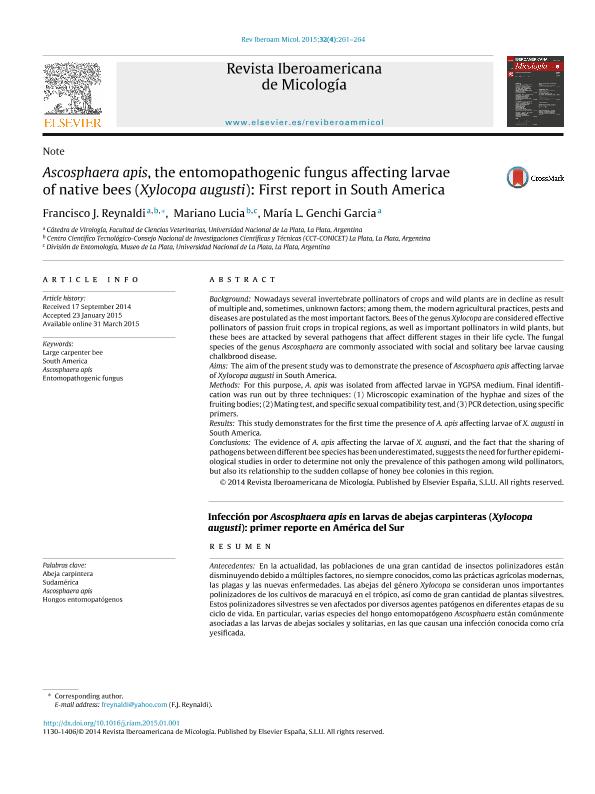Artículo
Background: Nowadays several invertebrate pollinators of crops and wild plants are in decline as resultof multiple and, sometimes, unknown factors; among them, the modern agricultural practices, pests anddiseases are postulated as the most important factors. Bees of the genus Xylocopa are considered effectivepollinators of passion fruit crops in tropical regions, as well as important pollinators in wild plants, butthese bees are attacked by several pathogens that affect different stages in their life cycle. The fungalspecies of the genus Ascosphaera are commonly associated with social and solitary bee larvae causingchalkbrood disease. Aims: The aim of the present study was to demonstrate the presence of Ascosphaera apis affecting larvaeof Xylocopa augusti in South America. Methods: For this purpose, A. apis was isolated from affected larvae in YGPSA medium. Final identification was run out by three techniques: (1) Microscopic examination of the hyphae and sizes of thefruiting bodies; (2) Mating test, and specific sexual compatibility test, and (3) PCR detection, using specificprimers. Results: This study demonstrates for the first time the presence of A. apis affecting larvae of X. augusti inSouth America. Conclusions: The evidence of A. apis affecting the larvae of X. augusti, and the fact that the sharing ofpathogens between different bee species has been underestimated, suggests the need for further epidemi-ological studies in order to determine not only the prevalence of this pathogen among wild pollinators,but also its relationship to the sudden collapse of honey bee colonies in this region. En la actualidad, las poblaciones de una gran cantidad de insectos polinizadores están disminuyendo debido a múltiples factores, no siempre conocidos, como las prácticas agrícolas modernas, las plagas y las nuevas enfermedades. Las abejas del género Xylocopa se consideran unos importantes polinizadores de los cultivos de maracuyá en el trópico, así como de gran cantidad de plantas silvestres. Estos polinizadores silvestres se ven afectados por diversos agentes patógenos en diferentes etapas de su ciclo de vida. En particular, varias especies del hongo entomopatógeno Ascosphaera están comúnmente asociadas a las larvas de abejas sociales y solitarias, en las que causan una infección conocida como cría yesificada. Objetivos: El objetivo del presente estudio fue demostrar la presencia de Ascosphaera apis en larvas de Xylocopa augusti en Sudamérica. Métodos: Se aisló A. apis de las larvas afectadas en medio YGPSA. La identificación final fue realizada utilizando tres técnicas: 1) examen microscópico del tamano˜ de las hifas y los cuerpos de fructificación; 2)test de apareamiento y test específico de compatibilidad sexual, y 3) detección mediante PCR, utilizando iniciadores específicos. Resultados: En este estudio se ha registrado por primera vez en Sudamérica la presencia de A. apis en larvas enfermas de la abeja nativa X. augusti. Conclusiones: La presencia de A. apis en larvas enfermas de X. augusti, sumada al hecho de que se ha subestimado la presencia de los mismos patógenos en diferentes especies de abejas, evidencia la necesidad de realizar más estudios epidemiológicos para determinar no solo la prevalencia de este patógeno entre polinizadores silvestres, sino también su relación con el repentino colapso de las colonias de abejas de la miel en esta región.
Ascosphaera apis, the entomopathogenic fungus affecting larvae of native bees (Xylocopa augusti): First report in South America
Título:
Infección por Ascosphaera apis en larvas de abejas carpinteras (Xylocopa augusti): primer reporte en América del Sur
Fecha de publicación:
10/2015
Editorial:
Asociacion Española Micología
Revista:
Revista Iberoamericana de Micología
ISSN:
1130-1406
Idioma:
Inglés
Tipo de recurso:
Artículo publicado
Clasificación temática:
Resumen
Archivos asociados
Licencia
Identificadores
Colecciones
Articulos(CCT - LA PLATA)
Articulos de CTRO.CIENTIFICO TECNOL.CONICET - LA PLATA
Articulos de CTRO.CIENTIFICO TECNOL.CONICET - LA PLATA
Citación
Reynaldi, Francisco José; Lucia, Mariano; Genchi García, María Laura; Ascosphaera apis, the entomopathogenic fungus affecting larvae of native bees (Xylocopa augusti): First report in South America; Asociacion Española Micología; Revista Iberoamericana de Micología; 32; 4; 10-2015; 261-264
Compartir
Altmétricas




